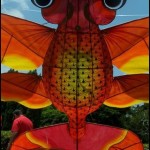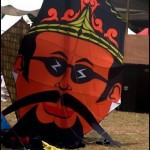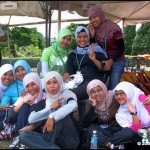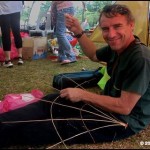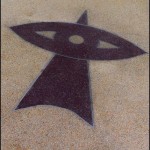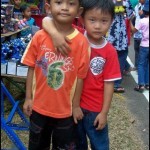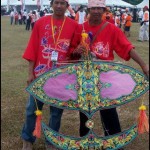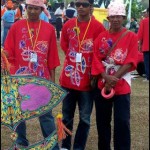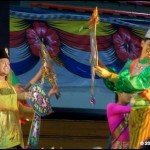Once upon a time there was a fast growing industrial town in Malaysia called Pasir Gudang. This was a very successful area of Malaysia with many growing industries, factories, and a vibrant multi-cultural work force.
There was one final ingredient that was required to make this city of over 200,000 complete. That element was community spirit. The Authority of Pasir Gudang, the State governing body, wanted to bring a cultural identity, a commonality, a unifying thread to this newly developed region.
How did The Authority of Pasir Gudang solve this particular problem? The same way we do when we have a problem…with a kite.
To say they were committed to this project is an understatement. There has been no stone left unturned, no expense spared. The first thing they did was to landscape and turn over a dedicated kite flying field. That was followed by the beginning of a national kite making contest, then in 1995 started an impressive annual international kite festival, and then capped it off with the opening of a beautiful kite museum in 2002.
All aspects of this project were done with such passion and resolve that they provide a wonderful lead for all other countries to follow.
I really enjoy seeing how others do things, and there was a lot to see at the 13th International Pasir Gudang Kite Festival.
First things first; loosely translated, the word for kite in Malaysian is ‘layang-layang’ and the name of the kite shape is Wau, pronounced ‘wow’. The Wau is what we in the west call a moon kite.
Immediately upon arriving at the headquarters hotel in Malaysia on the evening of Monday 18 February 2008 a small group of us rushed next door to the sports arena and witnessed the conclusion of phase I of the national Wau competition. I had heard about this and was anxious to see it. It was phenomenal, what a beautiful site it was to see hundreds of high school age kids from across the country display their incredible works of kite art.
Each one was more beautiful then the next. I can’t imagine how the judges managed to pick one over the other. The judges themselves were incredibly impressive judging upwards of several hundred kites in one day. We arrived at 11:00 pm; the competition had been going on all day and wasn’t done yet.
These kites can take an average of 200 hours of extraordinary craftsmanship to make each one. The winner will take home a substantial cash prize. This is amazing dedication by the government towards keeping the skill, tradition, and culture of kite making alive and well in Malaysia.
The visual aspect of the kite judging was but one part of the final score. The kites were also scored on the sound their hummers made in flight, the angle of the kite in flight, as well as general kite flying characteristics.
In addition to the in depth national wau kite making competition, there was also a type of speed racer wau making competition. In this competition they worked in teams and the wau’s had to be 100% completed during the 4 days of the event; beginning construction on the morning of the first day at 8:300am and flying at 6:30pm on the end of the fourth day. These kites were equally impressive and I would have found this task hard to believe had I not seen it with my own eyes.
The 13th annual Pasir Gudang International Kite Festival was a huge undertaking. There were over 200 kite flyers from over 35 countries. The varieties of kites were vast. There were a lot of smiles and hand gesturing trying to get through the many different languages present on the field. The neighboring countries of China, Japan, Indonesia, Singapore, and several others sent especially large contingencies to the festival.
Truly thrilling for me was seeing the Indonesian team fly the 5 foot high, diamond shaped-leaf kites that they made and brought to the festival- they were absolutely amazing. I was able to learn a bit more about these remarkable kites, but of course i have a bunch more questions now that the excitement of the festival swirling around us has died down.
This Indonesian team came from South East Sulawesi, in the Muna district. Their word for kite is ‘kaghati’; the name of the leaf is ‘kolope’…their version of leaf kite is ‘kaghati kolope’. The kites are framed in bamboo, line is from the leaves of the pineapple tree, and parts of the Agel leaf, as well as Waru skin trunk are also used. It takes seven days to build one of the diamond shaped leaf kite that was 5 feet high by 4 feet wide. ‘Kaghati Kananu-Manu’ means children’s kite.
The Sultan, who was spry at 87, attended the kite festival on Saturday and there was much hoopla! He has been a strong supporter of the kiting movement in Malaysia and it is always an honor and beneficial for the kite world when he helps to turn the spotlight on it. There were music, dancing, and special demonstrations by this year’s guest of honor, France. Each year an individual country is highlighted and they participate in special kite programs at the festival.
Adjacent to the kite flying field is a magnificent Layang-Layang Muzuem, as kite museum is spelled in Malaysian. This labor of love was opened in 2002 during the kite festival’s 7th year. It is a unique three story building, originally built as and still working as a windmill. There are over 500 kites with 300 of them coming from the 13 states of Malaysia.
Everything about this museum is remarkable with the most beautiful wooden display cases made out of the local rubber trees. There is a library section with computers and other resource materials. The sidewalks surrounding the building have various wau kites designed into the sidewalk.
The entire country is committed to the permanent and year round support and promotion to the wau, Malaysia’s national symbol. The national airline of Malaysia, Malaysia Air has the image of the wau on the tail of their planes and as their corporate logo.
Parts of the permanent infrastructure of the surrounding town in Pasir Gudang have the most beautiful golden wau’s built into their light standards on the major roadways. Malaysia also has the wau on both the paper note of the one ringet (Malaysian currency is the Ringet), and the 50 cent coin.
The Authority of Pasir-Gudang, the states governing body, and the festivals elite organizing committee which made all this possible, deserves a huge amount of credit for seeing the potential of the kite. The kite we know and love, with its multitude of cultural diversity and unlimited learning potential, to act as their bonding agent.
Following the festival the kite flyers were given two choices of activities to choose from as a thank you day before departing Malaysia. One option was a day of shopping and the other was an overnight excursion to a fishing village.
I opted for the fishing village. It was stunning to be in a remote little alcove on the edge of the China Sea with a few good kite friends. Getting there was equally as breathtaking as we drove past miles of palm tree and coconut plantations and endless groves of rubber and date trees. The vegetation was extra lush and exotic to me in this tropical garden having come from a northern climate in the extreme grips of winter. We stayed at a privately owned little inn with a dozen rooms on the edge of the bay.
It was a great way to unwind before the 3 long flights back, which came in handy since I was…oh what’s the word…CRAZY enough to think I could take home a couple of Malaysian Wau’s and Indonesian leaf kites. But that’s another story.
The Pasir Gudang International Kite Festival is one of those events you must put high on your list of things to do. I was very fortunate to have Pasir Gudang festival veteran Troy Gunn as my guide and source of information, always helpful when you are the newbie. For festival details go to: www.kitefestpasirgudang.com
There is an excellent article about Malaysian kites, competitions and the Pasir Gudang event by Pierre Fabre in the winter 1997-98 volume 12 number 4 issue of Kitelines magazine. This just happens to be archived here at Kitelife.com
Until next time,
Meg Robinson-Albers
March 2008


